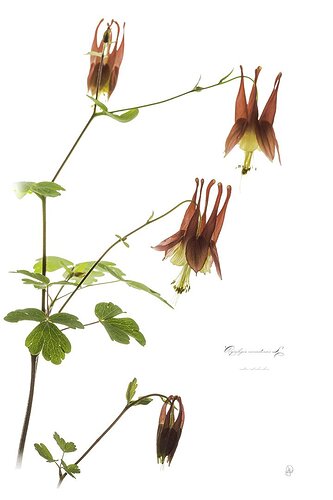“And I have to ask, how big a lightbox are you carting into the field and what make? Sounds like a fun thing to do.”
Hi Kathy,
Thanks for the comments. As soon as I posted the photograph, I knew the colors would get attention. The prints I make from the master file have a light, airy, diaphanous glow, especially on watercolor fine art paper. I guess the transfer to sRGB and JPEG, both of which have a more constrained color space, pushed the reds and yellows to a muddy lump.
I love finding flowers like Aquilegia because of their translucent petals and fine leaves. The challenge with making the images I’m working toward is balancing the strong backlight and beautiful transmitted tones against the front lights necessary for at least some reflected color and texture. I start with getting the backlight just right, watching the red flash of death on the LCD screen. That lets me know I have a pure white background. Then working with either the distance from the subject or manually controlling the output of the front two flashes, finding that sweet spot. Setting the camera file output on flat and saving a raw file, I have lots and lots of data to work with using Adobe Camera Raw. It’s a joy, both in the field and in front of the computer, to work with these flowers.
I carry different lightboxes depending on what I am expecting to find in bloom. The little flowers are up early spring, and a 12" X 5" box will do. Later for trees, big flowers, and shrubs, a 2’ hex works well. In the summer, I turn to garden plants and then the 4’ hex.
The portable soft boxes are from China. My daughter and family lived there for 6 years and we visited often. I would find what I wanted on a website Ali Express and then, if the manufacturer was in Shanghai, I could go directly to them and get the equipment an a very low cost. Even using Ali Express you can find great prices. A small one is $1.45 US. A 21" hex is $32 and free shipping to the US. They aren’t top of the line quality, but with a little care they are fine. Google Ali Express and search for soft boxes. Do a lot of comparison and watch out for some of the shipping costs.
Much of the work is along a dedicated bike trail that follows the Youghiogheny River in the Allegheny Mountains. The gear is carried in a bike trailer.
I’ve taken up too much of your time. If you have questions you are welcome to use the direct message.
Again, thanks for the comments.


